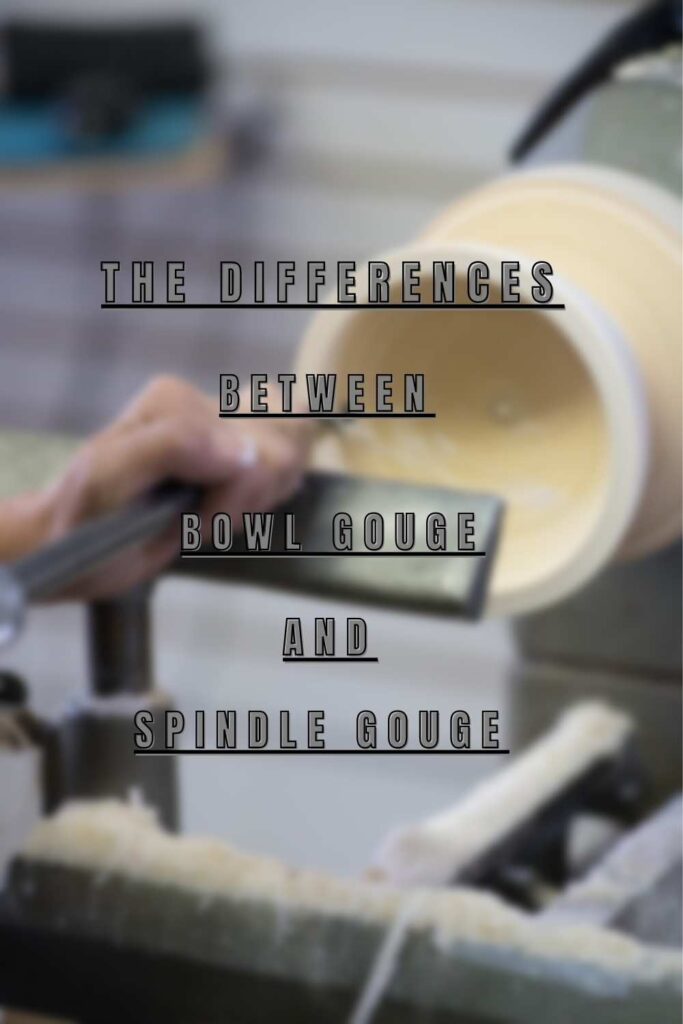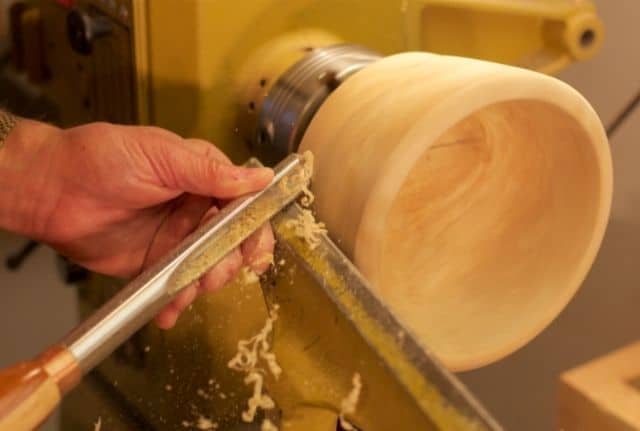Disclaimer: As an Amazon affiliate, I may earn a small percentage from qualifying purchases. This is at no extra cost to you. Learn more here.
Last Updated on January 8, 2025 by Larry Edwards
If you are new to woodturning, you might be wondering what’s actually the difference between a bowl gouge vs. a spindle gouge? It’s actually quite simple, as I’ll explain right now.
The main difference between a bowl gouge and a spindle gouge lies in the curves of the flute. The bowl gouge is curved and, as the name suggests, is perfect for turning bowls. The spindle gouge is flat in comparison, and is best suited for fine details and end grain work.
Now, I know there is still confusion with these two woodturning tools as they both look quite the same. But, if you look closely and get your hands on them, you will find the differences.
As you will be needing these two gouges on most of the occasion, it’s imperative that you know the differences very clearly. So, let me break it down to you.

Definition
Bowl Gouge: A bowl gouge is one of the most important woodturning tools that we use to remove woods from bowl blanks with efficiency. Bowl gouge can take much stronger forces from a larger diameter piece alternating between end grain and long grain. They also have a larger cutting edge because of their curvy flute size.
Spindle Gouge: It’s a woodturning tool specifically created to turn and shape spindle projects (long and thin end grain projects between lathe centers) and create detail cuts. They are lighter and shorter than a traditional bowl gouge.
Spindle gouges have shallower flutes, so you may have heard people calling them “shallow fluted gouges” as well. It is also known as “fingernail gouge” when fingernail grind is applied to shape the end of the gouge.
The Material-Removing Ability
Bowl Gouge: Bowl gouges are perfect for removing large amounts of wood from the curved sides of a wood-turning bowl. The ability to scrape out woods is definitely more significant than a roughing gouge.
Spindle gouge: Spindle gouge is not for roughing (removing bulk amount woods). We use the roughing gouge to handle this part.
They are mainly for detailed work, such as beads, cove, ogee curves (the “s” shape), etc in different types of turning projects. In fact, you will need a spindle gouge to make detailed cuts on your face grain bowl too.
The Differences in The Usage
Bowl Gouge: As the name goes, a bowl gouge is used to make wood bowls, closed forms, hollow forms by cutting and shaping them. Unlike the other turning tools, it is so versatile that you can use just a bowl gouge to make an entire bowl without adding any other chisels. But adding other tools in the arsenal definitely lets you create the finest detail and finish.
Spindle Gouge: The Spindle gouge will let you shape and create different detail work like the beads, coves, etc on long thin spindle workpieces.
Flute Size Difference
Bowl Gouge: On a spindle gouge, the flute is pretty close to the same radius as the bar itself. Where on a bowl gouge, the shape is either “U/V” or parabolic. Usually, a “V” shaped gouge comes with a fingernail grind that is ideal for detailing, roughing, and finishing.
Spindle Gouge: As a rule, spindle gouges have a much shallower flute than bowl gouges, unless it’s a spindle roughing gouge. You can easily recognize them by their external flute size.
Construction of The Steel
Bowl gouge: Bowl gouge once used to be made with HCS (High Carbon Steel). But later, many companies started using High-Speed Steel to avoid wearing down. The up-gradation is still going on, and you might have heard of the Cryogenic treated M2 steel that has been introduced very recently. It lasts even longer than the popular HSS.
Spindle gouge construction: The gouge rod is made from round stock and fluted quite similar to a bowl gouge with a relatively strong tang than the roughing gouges. Yes, they are also made from High-Speed Steel. But as I already said, it is not as strong as a bowl gouge because of the steel’s curved angle. A spindle gouge is more flatter than a bowl gouge, so the chances of getting catches are higher.
The Bevel Angle
Bowl gouge: Bevel angle determines your standing position and how you maneuver the tool. The options are pretty diverse that need a brief explanation. However, this comes between the 40-40 grind which is 40° angles to up to Micro Bevel Grind at 70° angles, depending on the project requirement.
Here are some types of bevel angle for a bowl gouge-
- 40-40 Grind
- Fingernail Grind
- Traditional Grind
- Irish Grind
- Modified fingernail Grind
- Micro Bevel Grind
- Swept Back Grind
Spindle gouge: The angle for a spindle gouge is much lower than a roughing gouge and bowl gouge. Although you can go up to 45° angle, it normally stays between 25° – 35°. Such as the case of fingernail gouge.
Sturdiness
Bowl gouge: As I stated that a bowl gouge is made from round stock and is much stronger. So, if you break a spindle gouge on a turning bowl, you might have a piece of metal flying at you with two sharp ends. So, don’t.
There is another reason for them to be stronger is the shape of the flute. The V-shaped flute lowers the chances for the gouge steel from getting bent in the opposite direction of the force while making a rough turn.
Spindle gouge: A spindle gouge is also made from solid round stock. But the tang is not as strong as the bowl gouge for side grain work because of the U-shaped flute. But it is enough to handle any “long thin side grain wood” and for much detail work on a bowl.
I always use my spindle gouge to make the tenon.
Reach Advantages
Bowl gouge: As the bowl gouge has a bulkier tip than the spindle gouge, it is not the ideal piece of the tool when it comes to tight and close spaces. This is one of the disadvantages of a bowl gouge.
Now the good part is that you can extend the reach of the cutting tip beyond the edge of the tool rest. This is very useful when turning more plunging into the bowl. You don’t need to set and move the tool rest very frequently.
Spindle gouge: Spindle gouges are best to reach as deep and pointed as a gouging tip can go. This comes in handy while working on a bowl, and you want to get the close deep cut. You can also use them to make the tenon also.
Sharpening Period For Both
Bowl gouge: Now, for a direct answer, you need to sharpen a bowl gouge more often than a spindle gouge. That’s because the bowl gouge always stays busy with the larger and stronger surface of a log.
The easiest way to tell if your tool needs to be sharpened is to look at the chips or dust. A blunt tip will produce chips instead of long shavings.
Spindle gouge: Just opposite a bowl gouge, a spindle gouge will help you make details on the spindle and bowls. So, the usage time is not as long as a bowl gouge. Besides, as you are not using them for roughing, the edge keeps sharp more prolonged than a bowl gouge. As a result, spindle gouge tends to sharpen less frequently.
Cutting Tip/Edge
Bowl Gouge: As I already mentioned above, the cutting edge here would not be as sharpened as a spindle gouge. So you basically cannot make the close cuts like a spindle gouge.
Spindle gouge: The cutting end of the spindle is thinner and sharper than the bowl gouge, which makes them perfect for intense work.

Frequently Asked Questions
There are so many questions out there related to bowl gouge vs. spindle gouge. It’s difficult to write them all in a single article, so you are most welcome to ask me in the comment. However, here are some of the most important questions that people ask.
The answer is mostly yes. You can use a bowl gouge instead of a rouging spindle gouge for scraping out the surface easily. Now, you may not have the sharp and detailed cuts as the spindle gouge does, but this will do the job.
The only time I use a spindle (detail) gouge on a bowl is for fine detail outside the bowl (for artistic purposes) and to finish off the dovetail for the tenon or mortise on the bottom. But these are light touches, just to clean up the “corner.”
They are not strong enough to cope with the pressure exerted on them. Spindle work doesn’t have that problem as the end grain is not being cut.
However, spindle gouges are not strong enough and have the wrong shape for side grain work.
The only place a bowl gouge will struggle is with very fine details on thin spindle work but, this also depends on the experience of the turner. There are folks out there who could get a good cut with any tool just down to their years of experience.
However, when it comes to tight coves, it’s a no-no.
You cannot really work inside a bowl with a spindle gouge. In fact, the usage on the outside interior with a spindle gouge is limited too. It doesn’t have the cutting wings.
I use a 1/2” spindle gouge on the outside of bowls, closed forms, and hollow forms. Don’t use inside. You can also use any 3/8” spindle gouge for detailing.
It depends on where you’re looking. On Amazon, you’ll see a Sorby bowl gouge and a Sorby spindle gouge, and they’ll look about the same. But one price will be almost 1/2 as much. Compare the length of the steel, the bowl gouge is longer, and that’s the price difference.
The bigger the bowl, the bigger the gouge you’ll want to use, both for hollowing and shaping the outside.
If you want a size that lets you work on different sized bowls, then going for ½” to turn small bowls under 12” swing is ideal. And if it’s a bowl between 12” to 15”, a 5/8” gouge will handle this with ease. You can use a ¾” for a much larger bowl.
A ½” gouge will handle most of your spindle projects with excellence. This is perfect for shaping and detail work.
Final Thoughts
Don’t confuse the spindle gouge with the roughing gouge. Take your gouges out and try to go through this article again to feel the differences. You cannot rough out anything with a spindle gouge.
Use a face shield and try to avoid catches by going slow on the passes. Ride the bevel as per the angle and avoid getting catches.
I hope this article will help you understand all the differences between a spindle vs. a bowl gouge. If you still think that I missed something important, let me know in the comment.
Till then-
Turn Big, Turn Safe. Welcome to the turning world!
